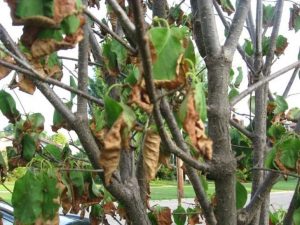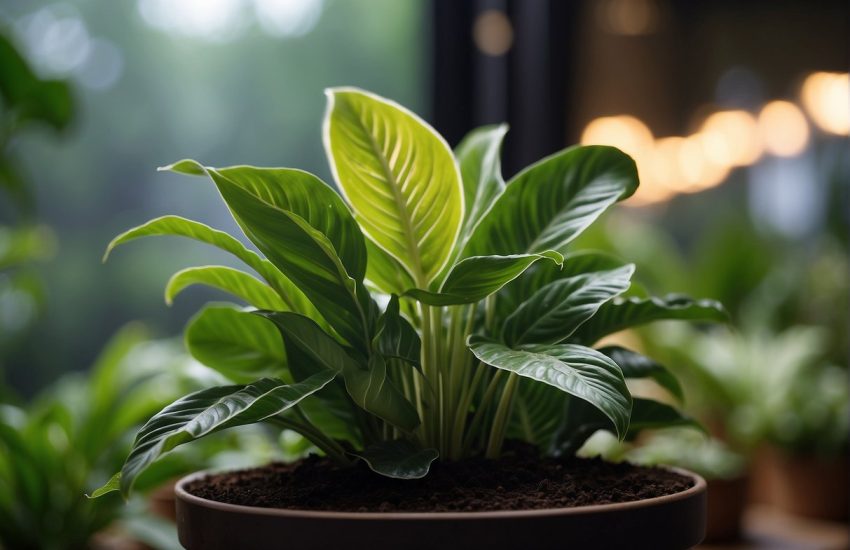How to Fix Lilac Leaves Turning Brown
Lilacs are a favorite of many gardeners for their sweet fragrance and attractive blooms. However, if you have recently noticed that the leaves on your lilac plants are turning brown, you may be wondering what is causing this problem and what you can do to fix it. In this article, we will discuss some possible causes of leaf discoloration in lilacs and suggest solutions to help correct the problem, so your plants can continue to thrive.
Causes of Lilac Leaves Turning Brown
There are several possible reasons why the leaves on your lilac plants may be turning brown.
- One possibility is a problem known as bacterial blight. This disease is caused by a bacteria called Pseudomonas syringae and can affect the leaves and stems of lilac plants. Symptoms include brown or black spots on the leaves, wilting, and leaf drops. Removing the plant’s affected leaves or branches is essential to control bacterial blight. You can also try pruning away any affected areas to promote new growth and be sure to disinfect your pruning tools after each use.

- Another possible cause of leaf discoloration is powdery mildew’s fungal disease. This disease is caused by a fungus called Erysiphe cichoracearum and affects the leaves and stems of lilacs. Symptoms include white or grayish-white powdery mildew on the leaves and stems. To control powdery mildew, you can try pruning away any affected plant areas. You can also treat the plant with a fungicide containing the active ingredient sulfur, which will help to kill the fungus.
- Lilac leaves may also turn brown if they are damaged by frost or cold weather. This damage is typically seen on the tips or margins of the leaves. If you think your lilac plants have been damaged by frost, you can try pruning away any affected leaves or stems, and be sure to protect the plants from further cold weather damage by mulching around the base of the plant, using a frost cloth, or covering the plant with a plastic tarp.
- Lilac leaves may turn brown if exposed to too much sun. This can happen if the plant is grown in a sunny location or if the leaves are exposed to direct sunlight for extended periods. If you think your lilac plants are getting too much sun, you can try pruning away some of the leaves to allow more air circulation and reduce the amount of sunlight, or you can move the plants to a shadier location if possible.
- Lilac leaves may also turn brown if insects are attacking them. Two common insects that can cause leaf damage are aphids and Japanese beetles. Aphids typically attack the undersides of the leaves and can cause them to turn yellow or brown. Japanese beetles will eat the leaves, which can also cause them to turn brown. If you think insects are attacking your lilac plants, you can try treating them with an insecticide, or you can manually remove the insects from the plants.
- Lilac leaves may also turn brown if they are not getting enough water. This can happen if the plant is not being watered regularly or if the soil is too dry. If you think your lilac plants are not getting enough water, you can try watering them more frequently. You can also try adding some organic matter to the soil to help retain moisture, or you can mulch around the base of the plant to help slow down evaporation.
- Lilac leaves may also turn brown if they are attacked by herbivores such as deer or rabbits. These animals will eat the leaves, which can cause them to turn brown. If you think a herbivore is attacking your lilac plants, you can try fencing around the plant to keep the animals out or treat the plant with a repellent.
- Lilac leaves may also turn brown if exposed to chemicals such as herbicides or insecticides. If you have recently applied chemicals to your lilac plants, this could cause leaf discoloration. To correct this problem, you can try washing the leaves with water to remove any residual chemicals and use a different type of chemical in the future.
- Lilac leaves may also turn brown if infected with a virus. Several viruses can infect lilac plants, including the tobacco mosaic virus and the cucumber mosaic virus. Symptoms of virus infection include leaf discoloration, stunted growth, and flower deformities. If you think your lilac plants are infected with a virus, you can try removing any affected leaves or stems. You can also try treating the plant with a virus-specific fungicide.
- Lilac leaves may also turn brown if they suffer from nutrient deficiencies. This can happen if the soil lacks certain nutrients, such as nitrogen, phosphorus, or potassium. Symptoms of nutrient deficiencies include leaf discoloration, stunted growth, and flower deformities. If you think your lilac plants suffer from nutrient deficiencies, you can try fertilizing them with a balanced fertilizer. You can also try adding some organic matter to the soil to help improve its nutrient content, or you can try using a different type of fertilizer in the future.
- Lilac leaves may also turn brown if a fungal disease attacks them. Two common fungal diseases affecting lilac plants are powdery mildew and leaf spot. Powdery mildew typically affects the leaves and stems of the plant, causing them to turn white or gray. Leaf spot typically affects the leaves of the plant, causing them to turn brown or black. If you think a fungal disease is attacking your lilac plants, you can try treating them with a fungicide, or you can remove any affected leaves or stems.
- Lilac leaves may also turn brown if exposed to cold temperatures. This can happen if the plant is grown in a cold climate or if the temperature suddenly drops. If you think your lilac plants are exposed to freezing temperatures, you can try covering them with a frost blanket or moving them to a warmer location, such as a greenhouse, during the winter.
- Finally, lilac leaves may also turn brown if they are simply old and starting to die. This is a natural process and is nothing to worry about. If you want to prevent this from happening, you can try pruning the plant regularly to remove any old or dying leaves, or you can try to fertilize the plant with a nitrogen-rich fertilizer.
Solutions for Lilac Leaves Turning Brown
If you have noticed that the leaves on your lilac plants are starting to turn brown, there are a few things you can do to try to fix the problem.
- First, you can try to determine the cause of the problem. If a herbivore attacks the leaves, you can try fencing around the plant to keep the animals out or treat the plant with a repellent.
- If the leaves are exposed to chemicals such as herbicides or insecticides, you can try washing the leaves with water to remove any residual chemicals. You can also try using a different type of chemical in the future.
- If the leaves are infected with a virus, you can try removing any affected leaves or stems. You can also try treating the plant with a virus-specific fungicide.
- If the leaves suffer from nutrient deficiencies, you can try fertilizing them with a balanced fertilizer. You can also try adding some organic matter to the soil to help improve its nutrient content, or you can try using a different type of fertilizer in the future.
- If fungal disease is attacking the leaves, you can try treating them with a fungicide, or you can remove any affected leaves or stems.
- If the leaves are exposed to cold temperatures, you can try covering them with a frost blanket or moving them to a warmer location, such as a greenhouse during the winter.
- Finally, if the leaves are old and starting to die, you can try pruning the plant regularly to remove any old or dying leaves, or you can try to fertilize the plant with a nitrogen-rich fertilizer.
How to grow healthy lilac bushes
Lilacs are easy to grow and make a beautiful addition to any garden. They can be grown in full sun or partial shade and prefer well-drained soil. Lilacs are relatively low maintenance and only need to be fertilized once a year. Mulch annually in spring with compost or other organic matter to help retain moisture and control weeds. Prune lilacs promote new growth and prevent the plant from becoming overgrown after blooming.
With proper care, lilacs can live for many years. Here are some tips for growing a healthy lilac plant:
- Plant lilacs in an area that receives full sun or partial shade: Lilacs need at least six hours of direct sunlight per day to bloom. However, they can also grow in partial shade.
- Plant lilacs in well-drained soil: Lilacs prefer soil rich in organic matter and drain well. Avoid planting them in soggy or waterlogged soil, as this can lead to root rot, a fungal disease that can kill the plant.
- Fertilize lilacs once a year: Lilacs only need to be fertilized once a year in spring. Use a balanced fertilizer or compost to give them the nutrients they need to grow, bloom, and stay healthy.
- Mulch lilacs annually: Mulching lilacs helps retain moisture and control weeds. Apply a layer of compost or other organic matter around the plant’s base in spring, keeping it away from the trunk.
- Prune lilacs after they bloom: Pruning lilacs helps promote new growth and prevents the plant from becoming overgrown. Cut back the stems by about one-third their length after the blooms have faded, being careful not to damage the buds for next year’s flowers.
- Water lilacs regularly: Lilacs must be watered regularly during the growing season. Make sure to water them deeply and allow the soil to dry out between watering, as too much water can lead to root rot.
- Protect lilacs from cold weather: Lilacs are sensitive to cold temperatures and can be damaged by frost or freezing weather. Cover them with a frost blanket or move them to a warmer location if necessary, being sure to remove the cover when the weather warms up, as too much heat can also be damaging.
- Remove dead or dying leaves: Dead or dying leaves can harbor diseases and pests. Remove them from the plant to prevent problems, and dispose of them properly, ensuring not to compost them.
- Monitor for pests and diseases: Lilacs are susceptible to pest conditions such as powdery mildew, leaf spot, and aphids. Watch for signs of these problems and treat them promptly to prevent damage to the plant.
- Check for transplant shock: Transplant shock is a common problem when moving lilacs to a new location. It can cause the leaves to turn brown and drop off. Be sure to water the plant well and give it time to adjust to its new environment before fertilizing or pruning it.
- Enjoy the blooms: Lilacs are known for their beautiful flowers. Enjoy them in your garden or cut them to bring indoors, being sure to remove any spent blooms to prevent the plant from setting seed, which can prevent it from blooming next year.
- Cut back dead wood: As lilacs age, they may produce dead wood. Cut this back to help promote new growth, careful not to damage the living tissue.
- Divide and replant lilacs: Lilacs can become overgrown and crowded after a few years. To rejuvenate them, divide the plants in spring or fall and replant them in new locations. Doing this every few years will help keep them healthy and vigorous and prevent them from becoming too big for their space.
Lilacs are beautiful and easy-to-grow plants that can add color and fragrance to your garden. With proper care, they can live for many years. Follow these tips to grow healthy lilac plants in your garden.
If you have recently noticed your lilac leaves turning brown, there are a few possible causes. The most common cause is dehydration, which can be remedied by watering the plant more frequently. Another probable cause is exposure to cold temperatures, which can be prevented by covering the plant with a frost blanket or moving it to a warmer location. Finally, lilacs are susceptible to pests and diseases, such as powdery mildew, leaf spot, and aphids. Monitor your plant for signs of these problems and treat them promptly. You can enjoy healthy lilac plants in your garden for many years with proper care.


